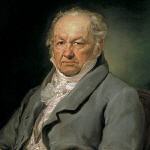
Francisco José de Goya y Lucientes (b. March 30, 1746, Fuendetodos, Spain--d. April 16, 1828, Bordeaux, Fr.), consummately Spanish artist whose multifarious paintings, drawings, and engravings reflected contemporary historical upheavals and influenced important 19th- and 20th-century painters.
Like Velazquez, Goya was a Spanish court painter whose best work was done apart from his official duties. He is known for his scenes of violence, especially those prompted by the French invasion of Spain. The series of etchings Los desastres de la guerra ("The Disasters of War", 1810-14) records the horrors of the Napoleonic invasion. His masterpieces in painting include The Naked Maja and The Clothed Maja (c. 1800-05). He also painted charming portraits such as Senora Sabasa Garcia.
For the bold technique of his paintings, the haunting satire of his etchings, and his belief that the artist's vision is more important than tradition, Goya is often called "the first of the moderns." His uncompromising portrayal of his times marks the beginning of 19th-century realism.